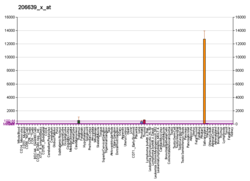Histatin 1
Protein-coding gene in the species Homo sapiens
| HTN1 | |||||||||||||||||||||||||||||||||||||||||||||||||||
|---|---|---|---|---|---|---|---|---|---|---|---|---|---|---|---|---|---|---|---|---|---|---|---|---|---|---|---|---|---|---|---|---|---|---|---|---|---|---|---|---|---|---|---|---|---|---|---|---|---|---|---|
| Identifiers | |||||||||||||||||||||||||||||||||||||||||||||||||||
| Aliases | HTN1, HIS1, histatin 1 | ||||||||||||||||||||||||||||||||||||||||||||||||||
| External IDs | OMIM: 142701; HomoloGene: 88658; GeneCards: HTN1; OMA:HTN1 - orthologs | ||||||||||||||||||||||||||||||||||||||||||||||||||
| |||||||||||||||||||||||||||||||||||||||||||||||||||
| |||||||||||||||||||||||||||||||||||||||||||||||||||
| |||||||||||||||||||||||||||||||||||||||||||||||||||
| |||||||||||||||||||||||||||||||||||||||||||||||||||
| Wikidata | |||||||||||||||||||||||||||||||||||||||||||||||||||
| |||||||||||||||||||||||||||||||||||||||||||||||||||
Histatin-1 is a protein that in humans is encoded by the HTN1 gene.[3]
References
Further reading
- Sugiyama K, Ogino T, Ogata K (1990). "Rapid purification and characterization of histatins (histidine-rich polypeptides) from human whole saliva". Arch. Oral Biol. 35 (6): 415–9. doi:10.1016/0003-9969(90)90202-L. PMID 2372245.
- Sabatini LM, Azen EA (1989). "Histatins, a family of salivary histidine-rich proteins, are encoded by at least two loci (HIS1 and HIS2)". Biochem. Biophys. Res. Commun. 160 (2): 495–502. doi:10.1016/0006-291X(89)92460-1. PMID 2719677.
- vanderSpek JC, Wyandt HE, Skare JC, et al. (1989). "Localization of the genes for histatins to human chromosome 4q13 and tissue distribution of the mRNAs". Am. J. Hum. Genet. 45 (3): 381–7. PMC 1683406. PMID 2773933.
- Oppenheim FG, Xu T, McMillian FM, et al. (1988). "Histatins, a novel family of histidine-rich proteins in human parotid secretion. Isolation, characterization, primary structure, and fungistatic effects on Candida albicans". J. Biol. Chem. 263 (16): 7472–7. doi:10.1016/S0021-9258(18)68522-9. PMID 3286634.
- Oppenheim FG, Yang YC, Diamond RD, et al. (1986). "The primary structure and functional characterization of the neutral histidine-rich polypeptide from human parotid secretion". J. Biol. Chem. 261 (3): 1177–82. doi:10.1016/S0021-9258(17)36072-6. PMID 3944083.
- Sabatini LM, Ota T, Azen EA (1993). "Nucleotide sequence analysis of the human salivary protein genes HIS1 and HIS2, and evolution of the STATH/HIS gene family". Mol. Biol. Evol. 10 (3): 497–511. doi:10.1093/oxfordjournals.molbev.a040022. PMID 8336540.
- Driscoll J, Zuo Y, Xu T, et al. (1996). "Functional comparison of native and recombinant human salivary histatin 1". J. Dent. Res. 74 (12): 1837–44. CiteSeerX 10.1.1.532.5059. doi:10.1177/00220345950740120601. PMID 8600179. S2CID 38609550.
- Iontcheva I, Oppenheim FG, Offner GD, Troxler RF (2000). "Molecular mapping of statherin- and histatin-binding domains in human salivary mucin MG1 (MUC5B) by the yeast two-hybrid system". J. Dent. Res. 79 (2): 732–9. doi:10.1177/00220345000790020601. PMID 10728974. S2CID 27558675.
- Flora B, Gusman H, Helmerhorst EJ, et al. (2002). "A new method for the isolation of histatins 1, 3, and 5 from parotid secretion using zinc precipitation". Protein Expr. Purif. 23 (1): 198–206. doi:10.1006/prep.2001.1493. PMID 11570863.
- Tamaki N, Tada T, Morita M, Watanabe T (2003). "Comparison of inhibitory activity on calcium phosphate precipitation by acidic proline-rich proteins, statherin, and histatin-1". Calcif. Tissue Int. 71 (1): 59–62. doi:10.1007/s00223-001-1084-0. PMID 12060866. S2CID 38221230.
- Strausberg RL, Feingold EA, Grouse LH, et al. (2003). "Generation and initial analysis of more than 15,000 full-length human and mouse cDNA sequences". Proc. Natl. Acad. Sci. U.S.A. 99 (26): 16899–903. Bibcode:2002PNAS...9916899M. doi:10.1073/pnas.242603899. PMC 139241. PMID 12477932.
- Yin A, Margolis HC, Grogan J, et al. (2003). "Physical parameters of hydroxyapatite adsorption and effect on candidacidal activity of histatins". Arch. Oral Biol. 48 (5): 361–8. doi:10.1016/S0003-9969(03)00012-8. PMID 12711380.
- Michels AA, Nguyen VT, Fraldi A, et al. (2003). "MAQ1 and 7SK RNA interact with CDK9/cyclin T complexes in a transcription-dependent manner". Mol. Cell. Biol. 23 (14): 4859–69. doi:10.1128/MCB.23.14.4859-4869.2003. PMC 162212. PMID 12832472.
- Gerhard DS, Wagner L, Feingold EA, et al. (2004). "The status, quality, and expansion of the NIH full-length cDNA project: the Mammalian Gene Collection (MGC)". Genome Res. 14 (10B): 2121–7. doi:10.1101/gr.2596504. PMC 528928. PMID 15489334.
- Bruno LS, Li X, Wang L, et al. (2005). "Two-hybrid analysis of human salivary mucin MUC7 interactions". Biochim. Biophys. Acta. 1746 (1): 65–72. doi:10.1016/j.bbamcr.2005.08.007. PMID 16203048.
- Cabras T, Fanali C, Monteiro JA, et al. (2007). "Tyrosine polysulfation of human salivary histatin 1. A post-translational modification specific of the submandibular gland". J. Proteome Res. 6 (7): 2472–80. doi:10.1021/pr0700706. PMID 17503797.
 | This article on a gene on human chromosome 4 is a stub. You can help Wikipedia by expanding it. |
- v
- t
- e















